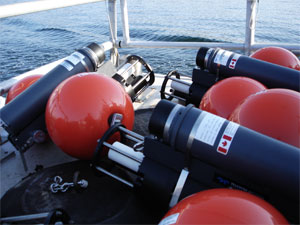 |
| Ron O'Dor is the lead scientist of the Ocean Tracking Network. (Danny Abriel Photo) |
“We know more about the dark side of the moon than we do about the ocean,” says AV���ֲ� biology professor Ron O’Dor. “And we know even less about our marine life—how they live, where they go.”
But Dr. O’Dor and marine scientists from around the world are about to change that: through the Ocean Tracking Network, they hope to shed light on the mysteries of where fish travel and why some stocks are disappearing.
The Ocean Tracking Network, or OTN, is an international partnership of marine scientists and researchers. Last week, they converged on AV���ֲ�, headquarters for the research initiative, for the inaugural OTN conference. In addition to officially launching the project, they met for two days to collaborate and share information that will allow the world to better understand the marine environment.
"We don't know nearly enough about the ocean, and bringing people together to share their knowledge is the most powerful tool we have in saving the ocean,” Dr. O’Dor, the OTN's scientific director, told reporters.
OTN researchers monitor the movements and migrations of tagged marine animals and the changing ocean conditions that affect them. The initiative includes universities, business, not-for-profits and government, representing all seven continents and 14 ocean regions.
The conference kicked off last Thursday with opening remarks from U.S. Navy Rear Admiral (retired), Richard West, a naval oceanographer and former president and CEO of the Consortium for Oceanographic Research and Education (CORE). Admiral West talked about the importance of ocean research and monitoring marine life. He impressed upon the research community to teach the public more about oceans and to ensure that governments around the world understand and appreciate the project and what’s needed to support it.
 |
| Acoustic receivers before they're deployed along "listening lines." |
Afterwards, representatives of the 14 ocean regions gave updates on progress in their regions and aspirations for the project. Between meetings, guests were treated to a trade show featuring the made-in-Canada technology that supplies OTN with its advanced equipment. Representatives from Satlantic Inc. and Amirix Systems Inc. of Halifax and Lotek Wireless Inc. of Newfoundland were on hand to showcase the equipment being used for OTN.
Just months prior to the conference, OTN receivers were deployed in the ocean along 22 kilometres of the Halifax line. The line is outfitted with tiny acoustic transmitters which pick up information from tagged fish on their whereabouts, habits and ocean conditions. Scientists on hand celebrated the knowledge that the technology is working; the first activity from tagged salmon was recorded through a number of transmissions received the week prior to the conference.
This data tells scientists where the fish go when they leave the river and how long it took them. In addition to collecting data from tagged marine life, sensors on the receivers provide researchers current and reliable records on the ocean’s temperature, depth, salinity, currents, chemistry and other properties.
Deployment of receivers will continue along 100 more kilometres on the Halifax line and off of B.C., Australia and Alaska in the summer. Next year, a dozen more lines will be deployed worldwide.
The mission of the OTN is to provide, for the first time in history, the most clear and detailed picture of marine life and changing ocean conditions. Being a global leader in all oceanographic research, AV���ֲ� sits at the centre of this exciting and promising initiative.
LINK:

